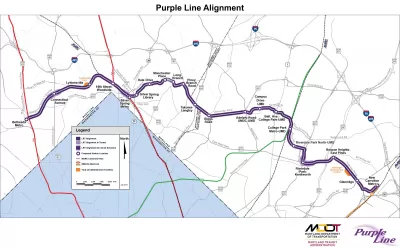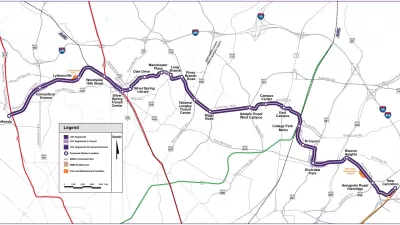The tool aims to help stakeholders "cut through regulatory complexity" and ensure equitable access to the light rail line's economic benefits.

A new tool from the University of Maryland’s National Center for Smart Growth Research and Education (NCSG) "provides easy access to a curated database of plans and regulations" in the Purple Line corridor, the area surrounding Maryland's upcoming Purple Line light rail. Cyrus Chimento, who worked on the project, writes in Greater Greater Washington that while the Purple Line project "presents massive benefits to locals such as increasing transportation access, decreasing pollution, and creating jobs," not all residents will share the benefits. "To combat this potential outcome, the Purple Line Corridor Coalition (PLCC) formed a community development agreement among businesses, nonprofits, government agencies, and community groups to make sure the Purple Line benefits are shared equitably among all residents and workers in the area." The coalition's goals include supporting and growing local businesses, improving access to housing choices, and building a thriving labor market.
The Plans and Regulations Information Tool aims to simplify the navigation of the area's complex regulatory environment. "The real power of the tool is to (very quickly) answer the general question underpinning those mentioned above: 'What plans or regulations apply to this place?' And since the Purple Line corridor spans multiple jurisdictions, we bring all the data together in one place." The tool is designed to assist developers and other interested stakeholders in understanding local regulations, and its designers hope "it can be a piece of the larger effort to make sure the benefits of the Purple Line investment accrue equitably."
FULL STORY: This tool helps create equitable development in communities surrounding the Purple Line

Alabama: Trump Terminates Settlements for Black Communities Harmed By Raw Sewage
Trump deemed the landmark civil rights agreement “illegal DEI and environmental justice policy.”

Planetizen Federal Action Tracker
A weekly monitor of how Trump’s orders and actions are impacting planners and planning in America.

Why Should We Subsidize Public Transportation?
Many public transit agencies face financial stress due to rising costs, declining fare revenue, and declining subsidies. Transit advocates must provide a strong business case for increasing public transit funding.

How Housing as a Financial Product Harms Communities
Institutional buyers who treat housing as an investment product become disconnected from the impacts of higher rents, displacement, and housing instability.

Blinded by the Light: When Brighter Headlights Decrease Safety
Bright LED headlights can create glare and reduce visibility for other drivers and pedestrians.

Study Links Covid and Poor Driving
The effects of the virus, including ‘brain fog,’ can make driving more difficult and dangerous.
Urban Design for Planners 1: Software Tools
This six-course series explores essential urban design concepts using open source software and equips planners with the tools they need to participate fully in the urban design process.
Planning for Universal Design
Learn the tools for implementing Universal Design in planning regulations.
Caltrans
Smith Gee Studio
Institute for Housing and Urban Development Studies (IHS)
City of Grandview
Harvard GSD Executive Education
Toledo-Lucas County Plan Commissions
Salt Lake City
NYU Wagner Graduate School of Public Service





























